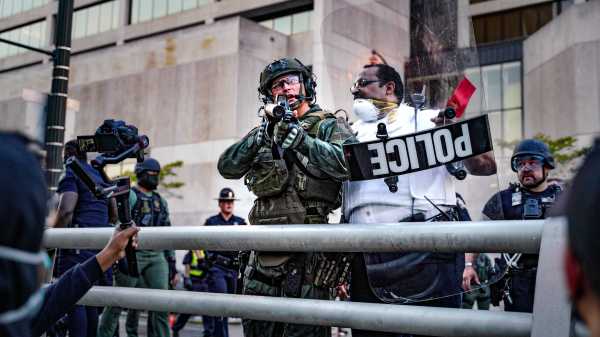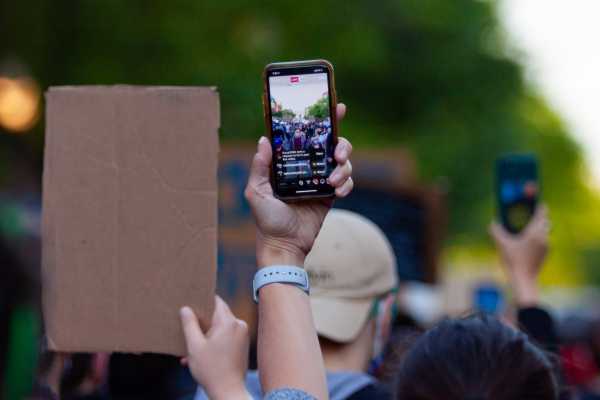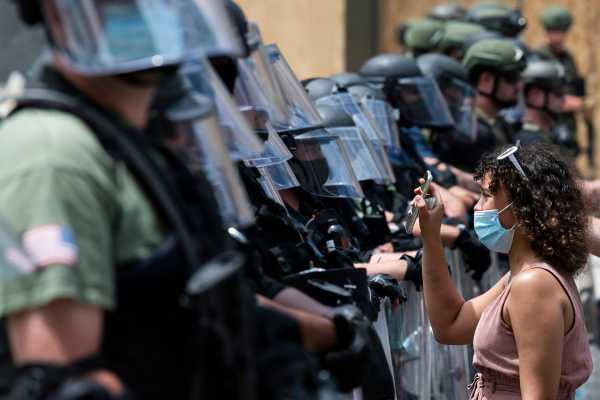
How protesters are turning the tables on police surveillance
Armed with smartphones, the public is holding law enforcement to account.
By
Sara Morrison and Adam Clark Estes
Jun 12, 2020, 7:10am EDT
Share this story
-
Share this on Facebook
-
Share this on Twitter
-
Share
All sharing options
Share
All sharing options for:
How protesters are turning the tables on police surveillance
-
Reddit
-
Pocket
-
Flipboard
-
Email
This story is part of a group of stories called

Uncovering and explaining how our digital world is changing — and changing us.

The way the Buffalo Police Department tells it, 75-year-old Martin Gugino “was injured when he tripped and fell” during a June 4 protest. This statement was quickly contradicted when footage from a nearby journalist’s phone showed that Gugino fell after two police officers pushed him. The man’s head hit the ground with a sickening crack and blood poured out of his ear. Most of the officers then walked on by him. The video swiftly went viral.
In the past, the Buffalo police’s claim might have been taken at face value and echoed by the news media. But as multiple versions of the video spread across social media, outrage grew to a tipping point. Both officers were swiftly suspended without pay and charged with assault. As local politicians and the police union tried to defend the rule of law, tens of millions watched one of the videos of the cops pushing Gugino, who is a longtime peace activist, to the ground. On Tuesday, President Trump tweeted, without evidence, that Gugino “could be an ANTIFA provocateur” who was “scanning” police communications and possibly faked his own fall. These conspiratorial claims were quickly debunked.
Trump’s tweet does, in a roundabout way, shed light on a dynamic unfolding as anti-police brutality protests sweep the nation. Typically, you think of police as the ones doing surveillance during a protest; they are aggressively monitoring the demonstrations around the country. Law enforcement even flew a Predator drone over protesters in Minneapolis last month. But now, with these protests, the president is paranoid that it’s the people who are surveilling the police. He’s not entirely wrong.
The Gugino video is just one of many recent incidents where activists, journalists, and bystanders have caught police responding to anti-police brutality protests with more police brutality. An NYPD officer was charged with assault after a video of him beating a protester went viral on social media, where he was identified. An array of video evidence proved that, ahead of a Trump photo op, police used chemical agents on peaceful protesters near the White House, despite the government’s official denial. And the video of George Floyd’s death is perhaps the most powerful example of a bystander’s footage swiftly disproving the police narrative.
There will surely be more videos like these that hold police to account. Internet-connected cameras are everywhere, and many people have them built into the phones in their pockets. These magical gadgets capture increasingly high-quality images that can be shared to countless apps and websites immediately. And because of the public’s burgeoning surveillance capabilities, the media has been less willing to blindly accept police statements that contradict videos and photos from multiple sources. This, combined with a new generation of apps that protesters can use to organize, is creating a new dynamic in these marches.
As always, the police are watching the protesters. But now, more than ever, the protesters are watching them right back.
An app for every action
As long has smartphones have existed, they’ve been important tools for activists. But there are a few notable innovations in how protesters are using apps to assist in their efforts. Appropriating a public safety app is chief among them.
Once derided as a problematic neighborhood watch service, Citizen is experiencing a surprising renaissance as an organizing and broadcasting tool for activists. The app is sort of a police scanner on steroids, as it uses proprietary AI to identify incidents from hundreds of first responder radio channels and then plots those activities on a map. Users can get alerts about things happening near them, including marches, protests, or police presence.
There’s also a visual aspect that makes using Citizen extra interesting during a protest. Anyone can submit their own incident or add comments, images, or live video from the scene to an existing events. While police scanner apps have also experienced an explosion in popularity, Citizen is becoming an effective way to monitor not only what’s happening with protests but also how police are responding. In the first week of June, more than 600,000 new users signed up for Citizen, which was shaping how they took to the streets.
“Having that level of granularity and information about what the police presence was like made me comfortable enough to participate,” Jorge Cueto, a new Citizen user, told the Wall Street Journal. “I felt like I had enough information to make an informed decision.”
Another category of app that’s seeing a surge in new users is secure messaging apps. Signal, a service that offers end-to-end encryption among other security-focused features broke into the top 10 most downloaded apps overall for the first time, likely because protesters are concerned about cops intercepting their communications. Long known to monitor social media, police can’t read messages sent on Signal unless they have access to the physical phones sending the messages, which explains why these kinds of apps are such valuable organizing tools. This week, Signal also added new features for secure photo and video sharing, including the ability to blur faces to protect identities.

Then there’s Instagram, which has become a powerful broadcasting platform. Along with Twitter and the power of the retweet, Instagram and its Stories feature have become a primary way for protesters to make viral images and videos that they want the world to see. Even with Instagram’s limited functionality, activists have been using the platform to spread messages, launch global campaigns against racism, and share countless images of people protesting and police, acting as counterprotesters, beating the protesters.
Police heavily armed with spy tools
While protesters are finding new, more secure ways to navigate and document demonstrations, police still employ militant surveillance strategies. This is not a new thing, but one has to wonder how effective it will be this time around.
Law enforcement has been caught surveilling legal, peaceful demonstrations, including Occupy Wall Street and Black Lives Matter protests. They’ve also been known to monitor people who have participated in protests and store that information in intelligence databases. Surveillance technology has also advanced significantly in the past few years, giving police the ability to target activists in real time. As documents from the American Civil Liberties Union show, during the demonstrations following the killing of Freddie Gray, the Baltimore County Police Department used a location-tracking, social media-monitoring tool called Geofeedia to find photos of people that were posted online. Police ran the images through facial recognition technology “to discover rioters with outstanding warrants and arrest them directly from the crowd.”
The growing list of advanced police surveillance technology also includes body cameras, automatic license plate readers, mobile surveillance towers, and drones. The week that George Floyd was killed, in fact, law enforcement flew a Predator drone, courtesy of Customs and Border Patrol, over protests in Minneapolis. Together, these tools enable police to collect data on thousands of people at once, even if those people aren’t suspected of or engaged in criminal behavior. Privacy advocates have long been concerned about the lack of regulations or laws around how police departments use surveillance technologies as well as the lack of transparency cops provide.
Police body cameras, specifically, have been propped up as a tool that can promote police accountability, but the reality has been complicated. Since police departments ultimately maintain a lot of control over what footage is collected — if it’s collected at all — and whether it’s released to the public, the extent to which body cams promote the greater good is questionable. Police have also been caught planting evidence for the benefit of body camera videos. There are several cases of officers’ body cameras not being turned on or falling off during incidents when they are needed most, and access to that footage behind law enforcement is often limited. Body cameras can also be used to gather footage of everyone who is at the scene, giving law enforcement a permanent record of any participants captured by the camera’s lens.
Protesters’ phones may also act as an unintentional surveillance camera for police. Photos or video of protests posted on social media provide law enforcement with another means of identifying who was at a certain place at a certain time, and even who they happened to be with. If you don’t want your photos to potentially be used against someone, be strategic in what you capture, either by angling your camera so no one’s identifying information is shown, or using blur tools to obscure it, and carefully consider what you’re posting and why.
This goes both ways. Protesters, journalists, and bystanders are also increasingly recording the actions of police officers. In a way, the people’s cameras are doing the jobs that body cams were designed to do.
The power of crowdsourcing
As police surveillance technology becomes more sophisticated, there are well-founded fears that any images taken of you during the protests can still be analyzed by police after the fact. Police departments often have access to sophisticated AI and facial recognition software. While we don’t yet know the extent to which law enforcement responding to the current demonstrations will use the technology, we do know that facial recognition has been used to identify people who have been at similar demonstrations in the past and that some have expressed interest in using it now. At the same time, backlash to police use of facial recognition has become so fierce that companies like IBM, Amazon, and Microsoft recently announced that they would stop selling the technology to law enforcement.
Post-facto analysis also works both ways, though. In terms of sheer attention span, law enforcement is almost certainly outnumbered by the general public who are watching and sharing countless hours of footage from protests. This kind of crowdsourced action has helped identify officers in cases where badge numbers are being obscured during clashes. That was the case with NYPD officer Vincent D’Andraia, who was identified by social media users and charged with assault after video of him shoving a protester made the rounds.

Witness videos also played a crucial role in debunking the Trump administration’s constantly changing account of how law enforcement cleared an area near the White House before the president’s now notorious photo op in front of St. John’s Church. Officers from an assortment of agencies cleared DC’s Lafayette Square of largely peaceful protesters to give Trump safe passage from the White House to a church. Multiple videos showed officers in riot gear attacking journalists, shooting pepper balls at crowds, and throwing various exploding grenades.
The incident quickly devolved into a familiar debate about what the government said happened and what evidence provided by the public suggested was true. Attorney General Bill Barr denied that the crowd was peaceful and that tear gas was used. But almost simultaneously with the government’s denials, videos emerged showing police violently attacking relatively calm protesters. Meanwhile, evidence found at the scene confirmed that tear gas was indeed present, though that fact could also be confirmed from videos shot by protesters and news outlets.
The government’s behavior as well as its duplicitous denials of what happened at Lafayette Square has not been well received. The incident has even been criticized by some members of the National Guard who were there following orders. The Arlington County police also pulled its forces out of the city after the event, saying their “health and safety” was jeopardized “for a purpose not worthy of our mutual aid obligations.”
This trend in speaking truth to power represents a meaningful shift. For years, the narrative around police brutality has been frustrated, at least to some degree, by police being able to make false claims about reality and get away with it. The board president of the National Police Accountability Project, Michael Avery, recently told the Associated Press that “what is happening now with video, this is getting out into the larger world, into the media, into white communities, suburban communities, and people outside the affected communities are becoming more aware of what’s going on.”
There’s reason to believe that the positive change will continue. While laws are being proposed that would curb or limit police surveillance, Americans’ right to record the police can’t be easily legislated away. It’s considered a right under the First Amendment to film government officials doing their jobs in a public space.
But it does seem that police officers are finally starting to realize that not only are they being filmed, but that they may be held accountable for their actions in the resulting video. The National Lawyers Guild accused police across the nation of targeting its legal observers in violent attacks and arrests; Gothamist reported one observer said he was accused of “illegal counter-surveillance against police.”
This looks to be a battle that the police can’t win. They no longer control the narrative, and it’s hard to imagine that they’ll get it back. Cameras are everywhere, they’re here to stay, and even children know how they can be used to bear witness. George Floyd’s killing was filmed by Darnella Frazier. She’s only 17 years old.
Rebecca Heilweil contributed reporting to this story.
Open Sourced is made possible by the Omidyar Network. All Open Sourced content is editorially independent and produced by our journalists.
Support Vox’s explanatory journalism
Every day at Vox, we aim to answer your most important questions and provide you, and our audience around the world, with information that has the power to save lives. Our mission has never been more vital than it is in this moment: to empower you through understanding. Vox’s work is reaching more people than ever, but our distinctive brand of explanatory journalism takes resources — particularly during a pandemic and an economic downturn. Your financial contribution will not constitute a donation, but it will enable our staff to continue to offer free articles, videos, and podcasts at the quality and volume that this moment requires. Please consider making a contribution to Vox today.
Sourse: vox.com